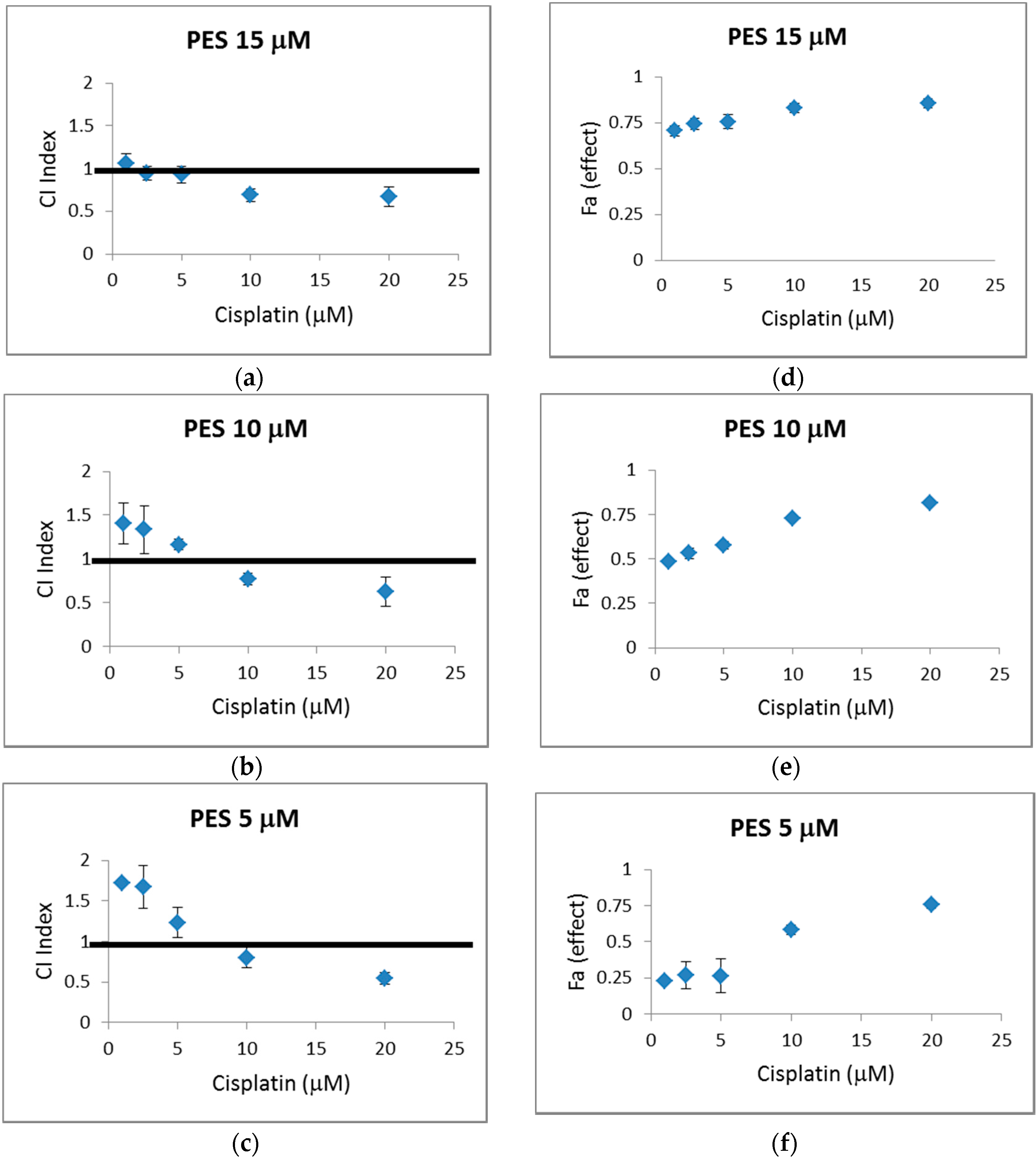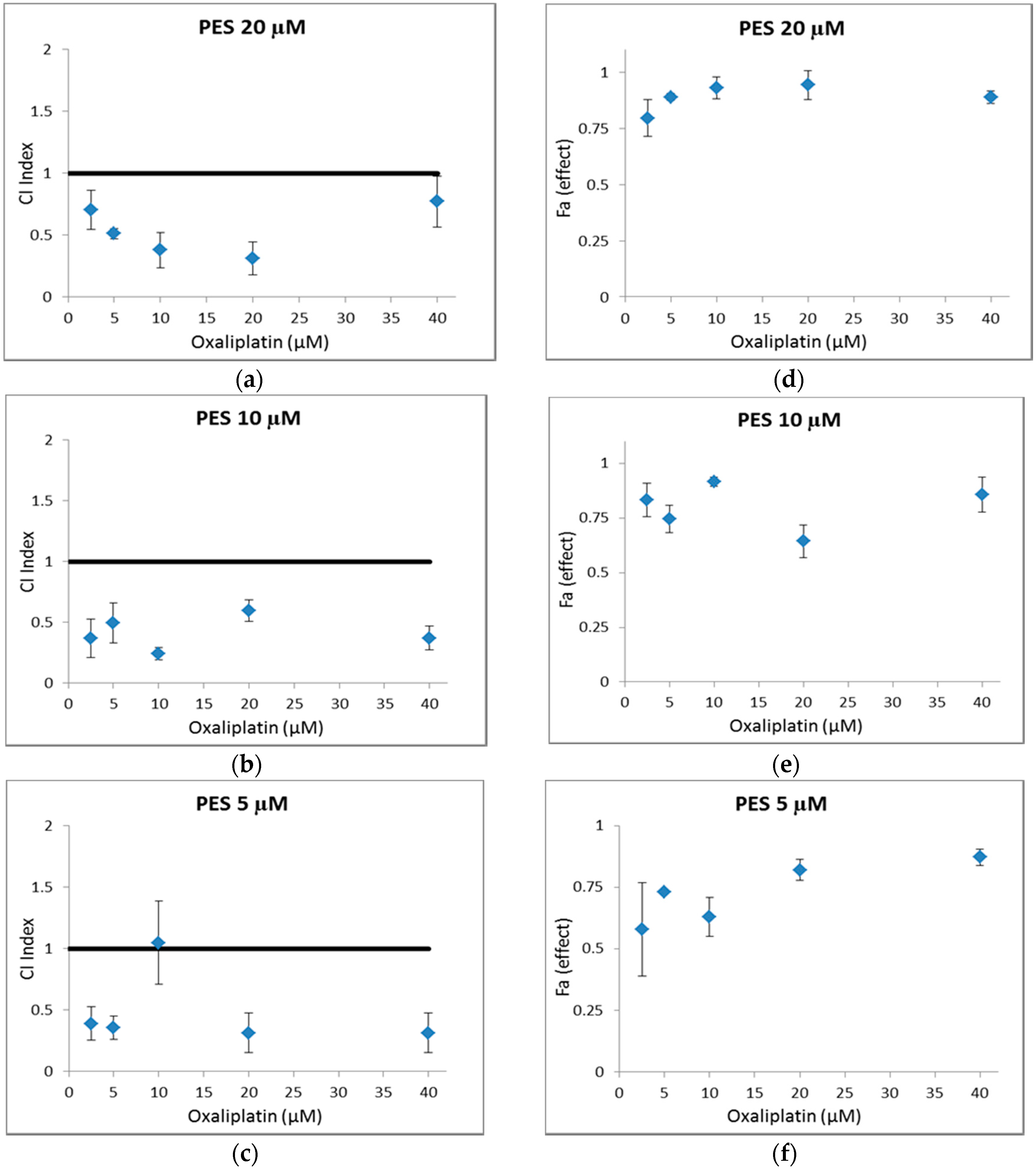Novel Improved Synthesis of HSP70 Inhibitor, Pifithrin-μ. In Vitro Synergy Quantification of Pifithrin-μ Combined with Pt Drugs in Prostate and Colorectal Cancer Cells
Abstract
:1. Introduction
2. Results and Discussion
2.1. Syntheses of Pifithrin-μ, PES
2.2. In Vitro Cytotoxicity
2.3. In Vitro Combination Study
3. Materials and Methods
3.1. Materials and Instrumentation
3.2. Syntheses of Pifithrin-μ
3.3. In Vitro Cell Culture
3.4. In Vitro Cytotoxicity Assays
3.5. In Vitro Cytotoxicity Combination Study
4. Conclusions
Supplementary Materials
Acknowledgments
Author Contributions
Conflicts of Interest
References
- Leu, J.I.J.; Pimkina, J.; Frank, A.; Murphy, M.E.; George, D.L. A small molecule inhibitor of inducible heat shock protein 70. Mol. Cell 2009, 36, 15–27. [Google Scholar] [CrossRef] [PubMed]
- Leu, J.I.J.; Pimkina, J.; Pandey, P.; Murphy, M.E.; George, D.L. Hsp70 inhibition by the small-molecule 2-phenylethynesulfonamide impairs protein clearance pathways in tumor cells. Mol. Cancer Res. 2011, 9, 936–947. [Google Scholar] [CrossRef] [PubMed]
- Khalil, A.A.; Kabapy, N.F.; Deraz, S.F.; Smith, C. Heat shock proteins in oncology: Diagnostic biomarkers or therapeutic targets? Biochim. Biophys. Acta 2011, 1816, 89–104. [Google Scholar] [CrossRef] [PubMed]
- Murphy, M.E. The Hsp70 family and cancer. Carcinogen 2013, 34, 1181–1188. [Google Scholar] [CrossRef] [PubMed]
- Galluzzi, L.; Giordanetto, F.; Kroemer, G. Targeting Hsp70 for cancer therapy. Mol. Cell 2009, 36, 176–177. [Google Scholar] [CrossRef] [PubMed]
- Babin, P.; Dunogues, J.; Felix, G.; Lapouyade, P.; Calas, R. Electrophilic properties of sulfamoyl chloride. Application to the synthesis of a b-acetylenic sulfonamides. J. Chem. Res. Synop. 1982, 1, 16–17. [Google Scholar]
- Kelland, L. The resurgence of platinum-based cancer chemotherapy. Nat. Rev. 2007, 7, 573–584. [Google Scholar] [CrossRef] [PubMed]
- Wheate, N.J.; Walker, S.; Craig, G.E.; Oun, R. The status of platinum anticancer drugs in the clinic and in clinical trials. Dalton Trans. 2010, 39, 8113–8127. [Google Scholar] [CrossRef] [PubMed]
- Galluzzi, L.; Vitale, I.; Michels, J.; Brenner, C.; Szabadkai, G.; Harel-Bellan, A.; Castedo, M.; Kroemer, G. Systems biology of cisplatin resistance: Past, present and future. Cell Death Dis. 2014, 5, e1257. [Google Scholar] [CrossRef] [PubMed]
- Fortin, S.; Brasseur, K.; Morin, N.; Asselin, É.; Bérubé, G. New platinum(II) complexes conjugated at position 7α of 17β-acetyl-testosterone as new combi-molecules against prostate cancer: Design, synthesis, structure-activity relationships and biological evaluation. Eur. J. Med. Chem. 2013, 68, 433–443. [Google Scholar] [CrossRef] [PubMed]
- Wu, M.; Li, H.; Liu, R.; Gao, X.; Zhang, M.; Liu, P.; Fu, Z.; Yang, J.; Zhang-Negrerie, D.; Gao, Q. Galactose conjugated platinum(II) complex targeting the warburg effect for treatment of non-small cell lung cancer and colon cancer. Eur. J. Med. Chem. 2016, 110, 32–42. [Google Scholar] [CrossRef] [PubMed]
- Florindo, P.R.; Pereira, D.M.; Borralho, P.M.; Rodrigues, C.M.P.; Piedade, M.F.M.; Fernandes, A.C. Cyclopentadienyl–ruthenium(II) and iron(I) organometallic compounds with carbohydrate derivative ligands as good colorectal anticancer agents. J. Med. Chem. 2015, 58, 4339–4347. [Google Scholar] [CrossRef] [PubMed]
- Kaiser, M.; Kuhnl, A.; Reins, J.; Fischer, S.; Ortiz-Tanchez, J.; Schlee, C.; Mochmann, L.H.; Heesch, S.; Benlasfer, O.; Hofmann, W.K.; et al. Antileukemic activity of the Hsp70 inhibitor pifithrin-[mu] in acute leukemia. Blood Cancer J. 2011, 1, e28. [Google Scholar] [CrossRef] [PubMed]
- Chou, T.-C. Drug combination studies and their synergy quantification using the chou-talalay method. Cancer Res. 2010, 70, 440–446. [Google Scholar] [CrossRef] [PubMed]
- Chou, T.-C.; Martin, N. Compusyn for Drug Combinations and for General Dose-Effect Analysis; ComboSyn, Inc.: Paramus, NJ, USA, 2005. [Google Scholar]
- Sekihara, K.; Harashima, N.; Tongu, M.; Tamaki, Y.; Uchida, N.; Inomata, T.; Harada, M. Pifithrin-mu, an inhibitor of heat-shock protein 70, can increase the antitumor effects of hyperthermia against human prostate cancer cells. PLoS ONE 2013, 8, e78772. [Google Scholar] [CrossRef] [PubMed]
- Dhara, S.C. A rapid method for the synthesis of cis-[Pt(NH3)2Cl2]. Indian J. Chem. 1970, 8, 193–194. [Google Scholar]
- Williams, K.M.; Poynter, A.D.; Hendrie, J.D.; Jackson, D.C.; Martin, V.K. Comparison of n-acetylmethionine reactivity between oxaliplatin and an oxaliplatin derivative with chiral (s,s) amine nitrogen atoms. Inorg. Chim. Acta 2013, 401, 64–69. [Google Scholar] [CrossRef] [PubMed]
- Patrone, J.D.; Yao, J.; Scott, N.E.; Dotson, G.D. Selective inhibitors of bacterial phosphopantothenoylcysteine synthetase. J. Am. Chem. Soc. 2009, 131, 16340–16341. [Google Scholar] [CrossRef] [PubMed]
- Sample Availability: Samples of pifithrin-μ are available from the authors.





| Test Compounds | PC-3 | DU145 | LNCaP | HT29 | LoVo | HCT116 |
|---|---|---|---|---|---|---|
| Pifithrin-μ | 17.4 | 18.8 | 21.6 | 40 | 5 | 26 |
| Cisplatin | 6.01 | 4.02 | 5.3 | - | - | - |
| Oxaliplatin | - | - | - | 9 | 0.5 | 0.3 |
| Cisplatin Concentration | Pifithrin-μ 15 µM | Pifithrin-μ 10 µM | Pifithrin-μ 5 µM |
|---|---|---|---|
| 20 µM Cisplatin | 20, 15 | 20, 10 | 20, 5 |
| 10 µM Cisplatin | 10, 15 | 10, 10 | 10, 5 |
| 5 µM Cisplatin | 5, 15 | 5, 10 | 5, 5 |
| 2.5 µM Cisplatin | 2.5, 15 | 2.5, 10 | 2.5, 5 |
| 1 µM Cisplatin | 1, 15 | 1, 10 | 1, 5 |
| Oxaliplatin Concentration | Pifithrin-μ 20 µM | Pifithrin-μ 10 µM | Pifithrin-μ 5 µM |
|---|---|---|---|
| 40 µM Oxaliplatin | 40, 20 | 40, 10 | 40, 5 |
| 20 µM Oxaliplatin | 20, 20 | 20, 10 | 20, 5 |
| 10 µM Oxaliplatin | 10, 20 | 10, 10 | 10, 5 |
| 5 µM Oxaliplatin | 5, 20 | 5, 10 | 5, 5 |
| 2.5 µM Oxaliplatin | 2.5, 20 | 2.5, 10 | 2.5, 5 |
| Combination Index (CI) | Description |
|---|---|
| <0.1 | Very strong synergism |
| 0.1–0.3 | Strong synergism |
| 0.3–0.7 | Synergism |
| 0.7–0.85 | Moderate synergism |
| 0.85–0.9 | Slight synergism |
| 0.9–1.10 | Nearly additive |
| 1.1–1.2 | Slight antagonism |
| 1.2–1.45 | Moderate antagonism |
| 1.45–3.3 | Antagonism |
| 3.3–10 | Strong antagonism |
| >10 | Very strong antagonism |
© 2016 by the authors. Licensee MDPI, Basel, Switzerland. This article is an open access article distributed under the terms and conditions of the Creative Commons Attribution (CC-BY) license ( http://creativecommons.org/licenses/by/4.0/).
Share and Cite
McKeon, A.M.; Egan, A.; Chandanshive, J.; McMahon, H.; Griffith, D.M. Novel Improved Synthesis of HSP70 Inhibitor, Pifithrin-μ. In Vitro Synergy Quantification of Pifithrin-μ Combined with Pt Drugs in Prostate and Colorectal Cancer Cells. Molecules 2016, 21, 949. https://doi.org/10.3390/molecules21070949
McKeon AM, Egan A, Chandanshive J, McMahon H, Griffith DM. Novel Improved Synthesis of HSP70 Inhibitor, Pifithrin-μ. In Vitro Synergy Quantification of Pifithrin-μ Combined with Pt Drugs in Prostate and Colorectal Cancer Cells. Molecules. 2016; 21(7):949. https://doi.org/10.3390/molecules21070949
Chicago/Turabian StyleMcKeon, Aoife M., Alan Egan, Jay Chandanshive, Helena McMahon, and Darren M. Griffith. 2016. "Novel Improved Synthesis of HSP70 Inhibitor, Pifithrin-μ. In Vitro Synergy Quantification of Pifithrin-μ Combined with Pt Drugs in Prostate and Colorectal Cancer Cells" Molecules 21, no. 7: 949. https://doi.org/10.3390/molecules21070949
APA StyleMcKeon, A. M., Egan, A., Chandanshive, J., McMahon, H., & Griffith, D. M. (2016). Novel Improved Synthesis of HSP70 Inhibitor, Pifithrin-μ. In Vitro Synergy Quantification of Pifithrin-μ Combined with Pt Drugs in Prostate and Colorectal Cancer Cells. Molecules, 21(7), 949. https://doi.org/10.3390/molecules21070949







